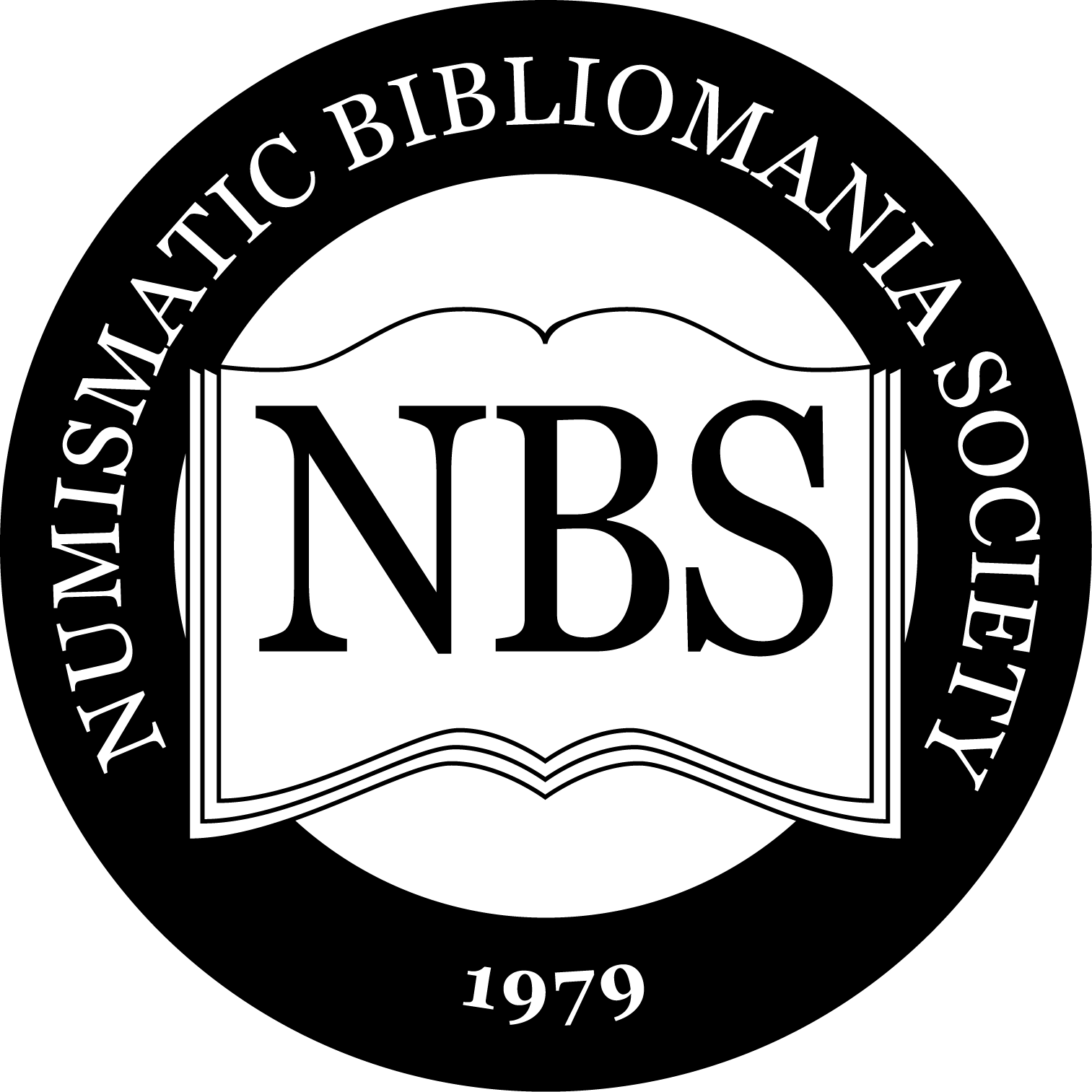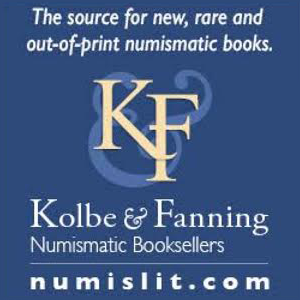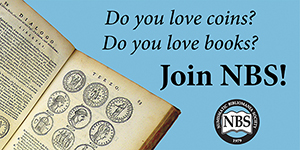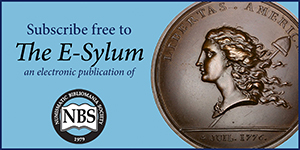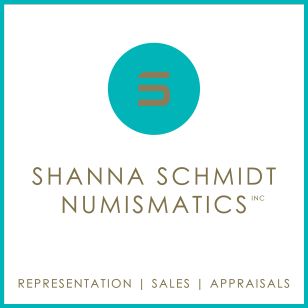A History of the NBS
The Numismatic Bibliomania Society, 1980-1997. A History of Seventeen Years in Fifteen Volumes.
By Joel J. Orosz, NLG
More than 100 numismatic bibliomaniacs met during the Cincinnati convention to attend the meeting of the newly-formed Numismatic Bibliomania Society. The meeting was an outgrowth of an informal gathering in St. Louis at the 1979 ANA Convention when approximately a dozen bibliomaniacs gathered for a dinner and discussed forming an organization for numismatic book and catalog collectors.
With these somewhat redundant sentences, an unsigned article on page 2712 of the November, 1980 issue of The Numismatist announced the birth of the Numismatic Bibliomania Society (NBS). The article, which occupied a full page, was headed "New Society for Bibliomaniacs Meets at Convention," and included photos of NBS "Chairman" George Frederick Kolbe and the featured speaker at the first meeting, John J. Ford, Jr. The "Cincinnati Convention" referred to was the 89th anniversary convention of the American Numismatic Association (ANA) held in the Queen City August 18-23, 1980. Here it was (in the Bamboo Room of Stouffer's Cincinnati Towers on August 18 at 8 p.m.) that the NBS was delivered, but it was a long time aborning.
The hobby of numismatics first reached a critical mass in America just prior to the Civil War, and many of the early coin hounds were literature collectors as well. Men such as John W. Kline, Ferguson Haines, and William Poillon went far beyond the requirements of basic references to collect books and catalogs for their own sake. The high water mark of 19th century numismatic bibliomania came in 1876, with the publication of Emmanuel Joseph Attinelli's superb bibliography of numismatic auction catalogs, Numisgraphics. Then came the bibliophile's dark night of the printed word; interest in the literature gradually declined after the nation's centennial, and during the first five decades of the 20th century, it was hard to find an American coin collector who cared a fig for books, catalogs, or periodicals except for the sake of pure reference.
The post-World War II era produced a remarkable cadre of young scholars, however, and men like John J. Ford, Jr., Eric P. Newman, and Walter H. Breen revived interest in the corpus of numismatic literature. These collectors soon had sources from which to buy. Just as the old Numismatic Gallery had its two "AKs" (Abe Kosoff and Abner Kreisberg), so did bibliophiles have their two "FKs", Frank Katen and (George) Frederick Kolbe. Katen was a dealer from New Haven, who during the 1960s gradually transformed his business from coins exclusively to literature primarily. Kolbe entered the field as a numismatic bibliopole in 1967. By the late 1970s, both men were running regular auctions for the growing numbers of the faithful.
As the decade of the 1970's drew to a close, the coin market was in a resounding state of boom. New devotees were flocking to the hobby, and some of them cared about collecting numismatic literature. This influx made it practical to establish a formal organization. Kolbe was a prime instigator, and his partner in creation was his fellow Californian, Jack Collins. Jack was truly a man of many parts - a sometimes TV-show producer and night spot owner, who was also a copper fanatic and a coin photographer without peer. Collins, who was inclined toward whimsy, overcame Kolbe's reservations (see The Asylum, Fall-Winter, 1985, p. 18) and gently mocked the obsessive nature of the pursuit by christening the newborn club "The Numismatic Bibliomania Society." The theme of eccentricity was carried even farther with the title of the club's journal: The Asylum. Such names were not universally admired (a "GC" flatly refused to join because of them; see The Asylum, Fall-Winter, 1980, p. 25), but they struck a chord with the majority of literature enthusiasts. The new society was loosely organized, with Kolbe serving informally as the only officer, and the two co-founders sharing duties as editors of The Asylum.
To be accurate, The Asylum was slightly older than the society itself. Kolbe and Collins had printed volume I, number 1 (Summer, 1980) prior to the Cincinnati ANA Convention for distribution to those in attendance. That first issue comprised sixteen pages (including covers, which were utilized to carry text). It was a strong initial effort, with articles written by noted large cent collector John W. Adams, along with dealer Q. David Bowers, and the late Geoffrey Charlton Adams. All, however, were reprints. The issue did feature substantive new articles by George Frederick Kolbe on Sylvester Sage Crosby's The Early Coins of America and descriptions of the types of photographic illustrations used in numismatic literature, including autotype, heliotype, and collotype plates. Although Kolbe and Collins were billed as co-editors for only the first two numbers of The Asylum, they in fact shared that duty through Volume II, No. 2 (Spring, 1983).
The NBS in its infancy was what would today be called a "virtual society," existing in fact only on the rare occasions when its members actually met. Since its membership was far-flung, and included some who never attended any meetings, it soon became clear that for most, The Asylum was the society. And therein lay a problem. Although nominally a quarterly, The Asylum was not actually published on that schedule. It would take four years, in fact, to complete two volumes, even with one double issue thrown in. Such challenges were not peculiar to The Asylum; difficulties in meeting a regular emission schedule are the oldest story in numismatic publishing. Nonetheless, until The Asylum could appear dependably, the very existence of the Society would be in question.
The Asylum appeared only episodically in the early 1980's but when it did land in mailboxes, it usually brought controversy in its train. The Fall-Winter, 1980 and Summer, 1981 issues carried, for example, a verbatim transcription of the speech by John J. Ford, Jr. that headlined the inaugural NBS meeting in Cincinnati. Ford, never one to mince words, took dead aim at a number of targets, most notably semi-literate coin dealers. One of Ford's auditors, however, touched off a bigger donnybrook than he did. In the second Ford installment, his erstwhile business associate, Walter H. Breen, complained about inept editing of cataloging he had done for a 1970 auction sale. This editing was perpetrated by, as Breen put it, "Don Taxay, who, at that time, headed the firm of Harmful, Crook - excuse me, Harmer, Rooke, and Co." This wisecrack did not amuse the principals of the firm in question, and in the next issue (Spring, 1982) Breen found it advisable to issue an apology to Harmer, Rooke, which, he contritely wrote, "is a company of estimable reputation in the rare coin field."
Breen was also the lightning rod for the most memorable of all controversies connected with the NBS, a veritable verbal barroom brawl stimulated by his article published in the Fall-Winter issue of 1980. Entitled "A Review of the Half Cent Literature," the piece was followed by a brief note from editor Jack Collins: "The above article was written ca. 1966, and was extracted from the unpublished manuscript on United States half cents written by the author. It is here published for the first time, with the gracious permission of the author. Any half-cent literature which has appeared since 1966 has not been discussed herewith."
In the next issue (Summer, 1981) Roger S. Cohen, Jr., author of the then-standard monograph on the series, American Half Cents: "The Little Half Sisters" fired off - or perhaps it would be more accurate to say flushed off - a letter to the editor that can only be described as "scatological." Noting that certain portions of the Breen article could only have been written after 1966, Cohen concluded that Breen had deliberately omitted mentioning The Little Half Sisters and that Collins' note was a transparent attempt to obscure the omission. Cohen blasted Collins as a "liar and a bigot" and concluded "the editor belongs to the depths He should be there also as a coprophagist."
Ignoring the temptation to speculate on the dietary habits of The Asylum's editor, Breen responded in the same issue that he had done some light editing on the manuscript in 1972, before he had heard of Cohen's book, but had not revised it since then. Breen concluded, "the parties concerned may bury their hatchets wherever they please, so long as it is not anywhere in my anatomy." Collins, much more combative than Breen, and much less verbose than Cohen, responded with a single sentence: "In my opinion American Half Cents is what a coprophagist would wrap his lunch in."
This exchange produced the only letter to the editor in the history of The Asylum which required an Oxford English Dictionary to comprehend. The late Raymond H. Williamson observed that "fortunately, the paper in this issue of The Asylum was not stercoraceous. However, no one except old Sterculeaceous himself would be pleased with such goings on; and even he was not retromingent!" (The Asylum, Spring, 1982, p. 13)
While the great Cohen-Collins coprophilia controversy was consuming the attention of NBS members, a serious challenge to the existence of the Society was slowly manifesting itself. By the autumn of 1982, the stercoraceous material was about to collide with the oscillating cooling device. In more than two years, The Asylum had appeared only five times out of the prescribed eight, and one of these was a double issue. The number for Spring, 1983 carried the NBS by-laws but the rest of the copy consisted largely of notices. The Society was withering; clearly dramatic action needed to be taken to revitalize it, and particularly get The Asylum published on a regular schedule.
Two Californians had founded the NBS; now a veritable gang of Golden Staters stepped forward to revive it. According to a letter sent to members on October 4, 1982, and signed by Cal Wilson, then a San Jose numismatic literature dealer, a group of bibliophiles had met impromptu a few days previously at the Long Beach Coin and Stamp Exposition and made some decisions. First, they proposed a slate of officers including Wilson for president, Louisville bibliophile extraordinaire Armand Champa for vice president, and California collector Allen Meghrig for secretary. Second, they called an NBS election for December of 1982. Third, they laid plans for the Society's first regional meeting, to be held at the Long Beach show in early 1983. Wilson also apologized for the irregular issuance of The Asylum, and attributed the erratic schedule to Collins being preoccupied with his monumental labors in preparation of Walter Breen's Encyclopedia of United States Half Cents, 1793-1857. With the imminent publication of the book, Wilson predicted that The Asylum would soon be published regularly. Collins and Kolbe were therefore once again listed on his slate as co-editors. The Wilson team carried the first formal NBS election that December, and the inaugural regional convention was held as scheduled in February of 1983 at Long Beach.
And then, nearly a year and a half of nothing. No issues of The Asylum, no meetings, no visible signs of life. President Wilson finally acted to shake the Society out of the doldrums, and found a figurative dynamo to serve as the new editor of The Asylum. Carling Gresham, a Florida dealer in numismatic ephemera, and an early enthusiast for the use of the personal computer, went to work with a will, and the first issue of The Asylum under his editorship was dated Summer, 1984. A colorful character, Gresham transformed the journal by adopting a chatty and informal style. He proved adept at inspiring new contributors; both Joel J. Orosz and Wayne Homren, for example, first published in The Asylum during Gresham's tenure. Carling also managed (with the aid of one double issue) to get the journal on a regular publishing schedule. His lively editorial comments skewered everyone; even co-founder Kolbe was not immune. When George moved from Mission Viejo to the higher elevation of Crestline, the editor delightedly referred to him as "Mountain Man Kolbe." The regular appearance of The Asylum sparked a revival in the fortunes of the Society, and membership began to grow. The second dawn for the NBS, however, was destined to have but a short life.
As much a part of Gresham as his energy and wit was his pride; and it was that pride that led him to be quick to utter and publish decided opinions. One such opinion, expressed about the editor of The Numismatist, caused a storm that ultimately cost Gresham his position. In an editorial appearing in the Summer, 1985 issue of The Asylum, Carling blasted off a salvo at the lack of coverage the NBS had received from hobby publications, concentrating his fire particularly on The Numismatist, " Where HRH [His Royal Highness] Harris [N. Neil Harris, editor/publisher] won't print anything about NBS!" Gresham went on: "HRH appears to be one of a number of employees at ANA Hq. who believe that we, collectors AND dealers are working for them NOT the other way around." (Gresham, as can be seen in the passage just quoted, was fond of capitalization for the purpose of placing emphasis on an idea.)
Reaction, and counter-reaction, was swift - and seething. In the following number (Fall & Winter, 1985), the issue was debated in no fewer than nine pages of letters. Large Cent stalwart Denis Loring wrote to say he was " incensed at the diatribe against Neil Harris " George Frederick Kolbe, by now NBS president, who had been copied on Loring's letter, wrote to say that he agreed with Loring's sentiments. Former president and current board member, Cal Wilson, who had also been copied by Loring, wrote to say that he had " sought out Neil Harris during the Baltimore [ANA] Convention, and on behalf of the Numismatic Bibliomania Society, offered our sincere apologies." Gresham printed all three letters, but responded in slashing style to each. Addressing Loring, he snapped "I reject you as a surrogate for HRH, and I reject your request for an apology." Gresham then suggested to Loring "Why don't you spend your time doing something creative for the NBS?" In response to Wilson's letter, Gresham accused him of groveling to Harris (who could offer publicity to Wilson's bibliopole business) and to Loring (who was one of Cal's major customers). Carling closed by snapping at Wilson: "Your patronizing attitude is very revulsive to me, but I understand the economics of your position."
This tart exchange was the last straw for Wilson, who on December 9, 1985 sent a letter to all board members recommending that Gresham be relieved of his duties and replaced by Joel J. Orosz, a charter member of the NBS who was then a museum curator. The board decided that Gresham should edit the first issue of 1986, with Orosz to take the reins for the remaining three. There followed instead an interregnum of several months, during which time no issue appeared, and the files of The Asylum, which were to have been transferred between the outgoing and incoming editors, were transferred only belatedly, and partially. As the summer of 1986 arrived, no issue of The Asylum had been produced for three-quarters of a year. Once again, the NBS appeared to be all but defunct.
During the next two years, the NBS did yet another imitation of Lazarus. Once again, the renaissance of the Society was led by the regular appearance of its journal. Editor Orosz managed to deliver it on time from the summer of 1986 through the summer of 1988. In fact, he became the first editor of The Asylum to produce four separate issues in a single calendar year (1987). This dependable publishing feat, however, was always a skin-of-the-teeth affair. Copy was in perpetually short supply, leading Orosz to write both a "From the Editor" column at the beginning, and a "Last Word" column at the end of every issue. Even so, three of the eight numbers emitted during these two years were an anemic sixteen pages. To his credit, deposed editor Gresham contributed four articles during these two years, providing the margin between publishing and missing an issue on more than one occasion. And there were some truly important pieces published: Gresham on Don Jose Toribio Medina, and P. Scott Rubin on the discovery of the 1907 ANA sale, for example. Yet there were also times when copy was so scarce that the editor resorted to a feature called "The Plagiarist's Corner," the content of which is self-explanatory.
The Asylum during these two years displayed much of its previous editor's influence. Orosz retained his predecessor's informal tone and even some of Gresham's caustic editorial style (for instance, in the Summer, 1988 issue Orosz lambasted the ANA for failing to even mention Dr. George F. Heath, the founder of both the Association and its journal, on the occasion of the centennial year of The Numismatist).
It was during the Orosz years that the naming controversy erupted once more. NBS member Q. David Bowers, writing in the Spring, 1987 issue, suggested that "The Asylum" had negative connotations, and offered "The Numismatic Bibliophile" as an alternative. The editor, hoping that a good controversy would produce reams of copy, agreed, and proposed a straw poll. Orosz was right - nearly three pages in the next issue were consumed by the great debate, with letters running 2:1 in favor of retaining both "Numismatic Bibliomania Society" and "The Asylum" as the names of the society and its journal. The official NBS election ballot for 1987 put the questions to the membership, which responded by a more than 2:1 margin to keep the names (as reported on page six of the Winter, 1987 issue). Jack Collins and his whimsical naming were finally vindicated by the membership.
While the nomenclature controversy was on its way to settlement, an unsung hero of the NBS was quietly creating a five-year index to The Asylum. California bibliophile William Malkmus created the index, which covered all numbers of The Asylum published from 1980 through 1987. This was an important achievement, and paved the way for others, as Malkmus would go on to create a first five, a six to ten, and a one to fifteen volume index to the periodical.
It seemed to be the fate of the NBS, in its early years, to suffer setbacks just when it appeared to have gained real momentum. It was such a stumbling block that ended Orosz's tenure as editor, and it came in the form of a drug bust. Not that the editor was peddling cocaine, mind you, but the shop that typeset and printed The Asylum proved to be a cover for those who were. Orosz at that time was not proficient with a personal computer, so he edited hard copy (and created some in long hand), then sent the entire mess to the Rayline Press in Orange County, California. When the family that had long owned Rayline sold it, the police soon descended upon the premises and found the new owners in possession of twelve ounces of cocaine, and the proofs of the Spring, 1988 issue of The Asylum. Both were impounded, and despite pleas from local NBS members that the street value of the proofs was considerably less than that of the cocaine, both remained in the police evidence room. The spring issue, therefore, had to be re-constituted from photocopies. Far worse than that, the sweetheart deal that the NBS had received from Rayline to set and print its journal was forthcoming from no one else. The spring and summer, 1988 issues were printed at market rates (more than twice the former cost), and the NBS treasury was all but looted. By mid-summer, there simply wasn't enough money left to create the autumn issue.
It had become painfully obvious that the publication costs needed to be reduced, so Orosz volunteered to fall upon his pen. The new editor chosen by president Armand Champa was David Herman Block, M.A., of Gainesville, Florida, who was proficient in the use of the personal computer. David Block's time in the editor's chair, from the summer of 1988 through the summer of 1991, is best described as an era of transition. A scholarly bloke, David moved away from the informal Gresham-Orosz style, toward that of a journal of record. Block's first issue (Autumn, 1988) was memorable for several reasons. First, it marked the debut of The Asylum's first column, "The Printer's Devil," written by ex-editor Orosz. The first installment of The Printer's Devil reported on another memorable event: the financial rescue of the NBS. At the Society's annual meeting during the 1988 ANA convention (fittingly held in Cincinnati, the birthplace of the NBS eight years before), Carling Gresham stood to offer a bookseller's store card at spontaneous auction for benefit of the NBS. After spirited bidding, president Champa knocked it down for $200. Then Denis Loring literally passed the hat, and $1,600.00 was collected. The financial crisis was over, and the Society would endure. Finally, this issue also featured a four-page photo essay on "The Invasion of Louisville," on July 23, 1988. President Champa had chartered a bus to bring 45 of his bibliophile friends from the Cincinnati ANA Convention to Louisville to ogle his superb collection. It was a milestone in the promotion of numismatic literature, and it helped to create an auspicious beginning to Block's editorship.
The Block era was marked by consistency, and by workmanlike efforts. Among the highlights were a census of sets of early volumes of The Numismatist by Ken Lowe, in the number for Spring, 1989; Frank Katen's article on the Wylie Hoard (Winter, 1989), and the first "Shammies Awards" in the Printer's Devil column, honoring excellence in the employment of hyperbole to increase sales (Summer, 1990). David himself was a conscientious and judicious editor, impressing all with his quiet dedication.
There was, however, one complicating factor. Block received copy, edited and formatted it, then sent it on electronically to another party for final vetting and publication. The other party was none other than ex-editor Carling Gresham. Controversy continued to swirl around Carling like gnats around the fruit bowl. Contributors to The Asylum soon began to suspect that Gresham was re-editing the copy after receiving it from Block. When they complained to David about the changes, he said there was nothing he could do; Gresham replied that he only printed what he received from the editor. Wits within the NBS began to speak of "Gresham's Law" - the bad copy drives out the good - and resentment grew within the ranks. The courtly Block kept the controversies out of the pages of The Asylum, but rancor was growing within the organization, and as 1990 closed, the situation was becoming serious.
The 1990 election of officers and board members for 1991 produced a "new deal" for the NBS. P. Scott Rubin, a New Jersey collector and past contributor to The Asylum, took the president's chair. Working rapidly behind the scenes, he solved the problem that had bedeviled those annoyed with Gresham: the lack of an effective alternative. Emerging from the board meeting at the ANA's centennial convention in Chicago in 1991, Rubin announced that the board had approved an editor who would do the whole job of editing and publishing at a cost lower than that of the Block/Gresham tandem. The new editor, starting with the Summer, 1991 issue, was Charles Davis, the noted bibliopole then located in Morristown, New Jersey. Davis was an excellent choice; his magnum opus, American Numismatic Literature, which was about to be released by Quarterman Publications, would bring him to the forefront of scholarship about numismatic literature. His erudition and his temperament caused many to regard him as the second coming of Edward Cogan.
Davis quickly set his stamp on the publication. While he retained, and even intensified, Block's scholarly approach, the non-controversial style was jettisoned. Charlie's time in the editor's chair, at nearly four years the longest in the history of the publication, was memorable for both its quality and its controversy - in the latter sense, at least, a throwback to the publication's early years. The quality was conspicuous. Davis himself contributed a superb article on W. Elliot Woodward (Winter, 1992); Eric P. Newman penned "Earliest Publications on American Numismatics" (Summer, 1992); John W. Adams recounted his experiences with the Wylie Hoard (Winter, 1993); Frank Van Zandt wrote on the rarity of early issues of The American Journal of Numismatics (Fall, 1993) and George Frederick Kolbe's discovery of two varieties of the Levick plate of Large Cents (Spring, 1994); and Michael Hodder exploded the old erroneous assumptions about the Lord Saint Oswald (Fall, 1994). Once more, William Malkmus stepped forward to create an index, this time to volumes six through ten. The quality was recognized by the outside world, as well; in 1993 the ANA selected The Asylum as the "Outstanding Specialty Numismatic Publication" an honor that was truly earned and deserved.
Another award could well have been bestowed upon editor Davis for creating the "Outstandingly Controversial Numismatic Publication." The fireworks began in the number for Summer, 1993, in which Davis excoriated the Numismatic Literary Guild as a "self-rewarding organization" that shunned NBS members when making its annual awards. The fur was still flying over that remark when, two issues later (Winter, 1994), Davis took withering aim at a piece written by sitting ANA president David Ganz: "One of the more nauseating articles we have read recently appeared in the January, 1994 issue of The Numismatist." The following issue (Spring, 1994), contained a critical review, authored by Cincinnati bibliophile Michael Sullivan, of the March 1994 sale of the Katen library, part 1. The venerable Mr. Katen was so miffed at the tone of the article that he promptly resigned his honorary life membership in the NBS. Taken together, all of these incidents ruffled the feathers of more than a few members of the Society.
Editor Davis was uneasy too, but not due to the many controversies. The massive and magnificent library of Armand Champa was then crossing the auction block, and Davis had been engaged by Auctions by Bowers and Merena to be the guest cataloger for a suite of four sales. The Champa auctions, produced under a very tight time line from November of 1994 through November 1995, proved the bibliographic equivalent of the twelve labors of Hercules. The strain of preparing the catalogs shown through in The Asylum for summer of 1994, in which Davis plaintively wrote "Your editor has been preoccupied with the Champa Library, and has been hard-pressed to edit this issue of The Asylum much less contribute to it." The NBS board reluctantly concluded early in 1995 that these time pressures necessitated a change, and asked Martin Gengerke, the celebrated author of American Numismatic Auctions, to succeed Davis as editor.
Gengerke, an employee of Stack's, accepted, but was able to stay at the editorial helm for a mere two issues. They were good ones, both featuring articles by David Alexander, but both arrived late in members' mailboxes. By the end of 1995, it was clear that, for the first time since 1986, the NBS had failed to deliver four copies of The Asylum in a calendar year. Once more, the board concluded that a change was desirable, and this time they decided to go "back to the future," by calling George Frederick Kolbe again to serve as editor.
Kolbe waded back into the fray with the assistance of Eric P. Newman. The number for Summer, 1996 contained reproductions of two broadsides, one British and one American, that delineated the "real and imaginary" monies of America, Europe, Asia, and Africa. Newman requested NBS members to study both and to help him with providing definitive dates for each of the broadsides. In the next number (Fall, 1996) it became the sad duty of the journal to report the death, from heart disease, of NBS co-founder Jack Collins, on September 27, 1996. About half of this issue was devoted to eulogies written by Joel J. Orosz, George Frederick Kolbe, P. Scott Rubin, and Michael Hodder. Then, in Spring, 1997, came more sad news: the passing of the one and only Armand Champa. Truly, the founding giants were beginning to leave the fold.
As the old exited, however, the new entered. P. Scott Rubin stepped down as president in 1997, succeeded by Michael Sullivan. Collectors like Dan Hamelberg moved to fill the void left by Armand Champa. Authors such as Wayne Homren, Phillip Carrigan, David Hirt, and David Lange added variety and spice to the pages of The Asylum. Old reliable William Malkmus, along with Michael J. Sullivan, spearheaded the third index (the one in your hands at the moment), which covered the first fifteen volumes of The Asylum. Another old reliable, Joel J. Orosz, continued to contribute "The Printer's Devil" in virtually every issue. With Kolbe at the helm, The Asylum has once again achieved a regular publication schedule.
Improbable as it may seem, the Numismatic Bibliomania Society and The Asylum, born in enthusiasm, nurtured with devotion, enlivened by controversy, and sustained through faith, have marched on for fifteen volumes and seventeen years. If the past is any indication, the NBS is resilient enough to survive setbacks, and ambitious enough to reach new heights. It is a fitting memorial, indeed, to co-founder Jack Collins, who always believed that the pen was mightier than the slab. The hobby of numismatic bibliomania is waxing as the century is waning, and there is every reason to hope that a new millennium is dawning not only on the calendar, but also in the annals of the NBS.
ACKNOWLEDGMENTS
The author wishes to thank George Frederick Kolbe and Michael Sullivan for their assistance in reviewing this history.
NBS is a proud supporter of both the ANA and ANS libraries.
